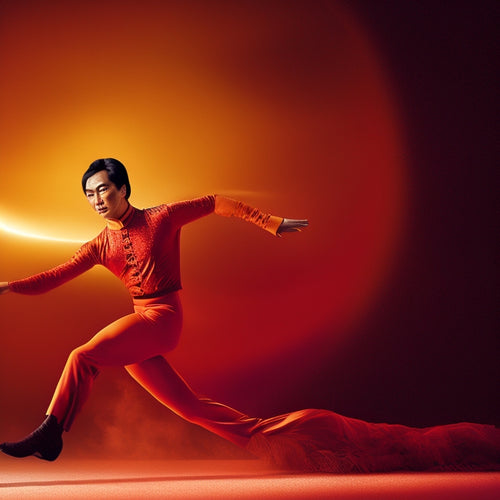
Renowned Photographer Captures Cultural Events in 1915-1918
Share
In the midst of world turmoil from 1915-1918, Arnold Genthe's lens preserved the vibrancy of cultural events, capturing the essence of an era. His photographs not only conveyed artistic expression but also fostered community connections, transcending linguistic and cultural barriers. Genthe's visual storytelling served as an essential tool for cultural documentation, preserving our collective past and providing a connection to historical events. His work safeguarded cultural identity, enabling future generations to connect with their heritage. As we gaze upon these frozen moments, we are invited to explore the significant societal impact of Genthe's photographs, which continue to transmit cultural values and traditions.
Key Takeaways
• Arnold Genthe's photographs during 1915-1918 captured cultural events, preserving the essence of the era's cultural identity.
• Genthe's work serves as a visual document of historical events, conveying the nuances of human experience during that time.
• His photographs provide a crucial connection to the cultural practices and traditions of the early 20th century.
• Genthe's visual storytelling facilitates cross-cultural understanding and enables future generations to connect with their heritage.
• Through his photographs, Genthe transmits cultural values and traditions, bridging the gap between past and present.
Capturing Cultural Moments in Time
Through the lens of a camera, cultural moments in time are frozen, allowing us to relive and reflect on the essence of a particular era, as photography captures the nuances of human experience.
The cultural significance of photography lies in its ability to convey artistic expression, preserving the essence of a moment in time. Additionally, photography fosters community connections, as visual storytelling transcends linguistic and cultural barriers, facilitating cross-cultural understanding.
Through the Lens of History
As we reflect on the power of photography to capture cultural moments, we must also consider the significant role it plays in preserving our collective past, as historical photographs provide a crucial connection to the events and experiences that have shaped our world.
Through the lens of history, photography serves as an essential tool for cultural documentation, imbuing historical significance to the moments it captures. The visual storytelling inherent in photography has a profound societal impact, allowing us to relive and learn from the past.
Preserving Cultural Identity Forever
Photography's capability to capture and preserve cultural practices and traditions safeguards the longevity of cultural identity, enabling future generations to connect with their heritage.
Through cultural documentation, photographers like Arnold Genthe have made a substantial contribution to the preservation of cultural heritage. Visual storytelling through images allows for the transmission of cultural values and traditions, ensuring their continuity.
By capturing the intricacies of cultural practices, photography bridges the gap between past and present, providing a window into the lives of our ancestors. As a result, cultural identity is preserved, and future generations can appreciate and learn from their heritage.
Through photography, cultural identity is forever preserved, allowing us to cherish and honor our collective past.
Frequently Asked Questions
What Inspired Arnold Genthe to Capture Cultural Events During This Time Period?
As the world teetered on the brink of chaos, Arnold Genthe's lens captured the cultural revival of the era, driven by a desire to document the human experience amidst war-torn landscapes, yielding a historical record of artistic expression.
How Did Genthe's Photography Style Influence Later Generations of Photographers?
Genthe's photography style, characterized by its Artistic Revival approach, left a lasting Visual Legacy, influencing later generations of photographers to focus on capturing nuanced cultural narratives, thereby shaping the trajectory of documentary photography.
What Role Did Genthe's Photographs Play in Shaping the Public's Perception of Cultural Events?
Genthe's photographs served as a visual lexicon, providing a nuanced visual representation of cultural iconography, thereby shaping the public's perception of cultural events by offering an intimate, unvarnished glimpse into the fabric of society.
Can Genthe's Photographs Be Considered a Form of Cultural Anthropology?
Genthe's photographs can be considered a form of cultural anthropology, as they employ visual ethnography to document and represent cultural practices, providing a nuanced cultural representation that fosters understanding and preserves cultural heritage.
How Did Genthe's Work Contribute to the Development of Modern Photography?
Genthe's work contributed to modern photography's development through his pioneering visual narrative, characterized by intimate portraits and street scenes, which showcased technical innovation, influencing subsequent generations of photographers to experiment with storytelling and artistic expression.
Related Posts
-

Elevate Your Dance Makeup Business Online
You're one step away from taking your dance makeup business global. A professional online presence is key, with 75% o...
-

Captivating Insights: Maos Last Dancer Analysis
Li Cunxin's memoir, Mao's Last Dancer, is a compelling narrative that delves into the intersection of art, identity, ...
-

Frozen Frenzy: Creative Crafts Galore
We're entering a winter wonderland of creativity, where snowflakes sparkle, ice castles shine, and magic unfolds in e...


